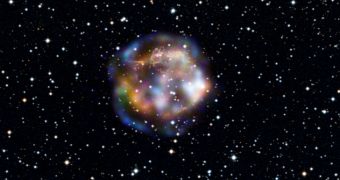Supernovae provide some spectacular images that anyone can appreciate, but they also provide valuable data to scientists. On the one hand, an image shot by NASA's NuSTAR space telescope and recently published makes for a great wallpaper on your phone.
On the other, one of the most distant Type Ia supernovae ever observed provides scientists with great insight into the very early days of our universe.
NASA's Nuclear Spectroscopic Telescope Array (NuSTAR) captured a new view of the remnants of the supernova that created Cassiopeia A, some 11,000 light years away.
The supernova exploded some 300 years ago, well, 11,300 years ago, and what we're seeing now is the aftermath. For such a massive and devastating explosion, it sure is a pretty thing to look at.
The false-color image compacts a large swatch of the light spectrum to the visible range. The blue tones are actually high-energy X-ray light while green and red are lower energy X-ray.
The blue outer edge is made up of radiation from the explosion slamming into the particles that get in its way at very close to the speed of light, resulting in the high energy X-ray light NuSTAR detected.

 14 DAY TRIAL //
14 DAY TRIAL //